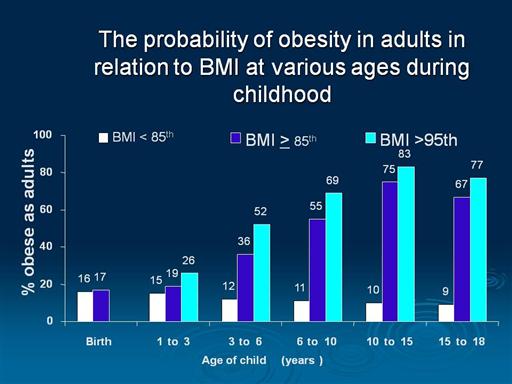| front |1 |2 |3 |4 |5 |6 |7 |8 |9 |10 |11 |12 |13 |14 |15 |16 |17 |18 |19 |20 |21 |22 |23 |24 | 25|26 |27 |28 |29 |30 |31 |32 |33 |34 |35 |36 |37 |38 |39 |40 |41 |42 |43 |44 |45 |46 |47 |48 |review |
 |
The tracking of BMI that occurs from childhood to adulthood is clearly shown in data from a study by Robert Whitaker (Children’s Hospital Medical Center in Cincinnati) and colleagues. They examined the probability of obesity in young adults in relation to the presence or absence of overweight at various times during childhood. For example, in children 10 to 15 years old, 10% of those with BMI-for-age < 85th percentile were obese at age 25 whereas 75% of those with a BMI-for-age > 85th percentile were obese as adults and 80% of those with a BMI-for-age > 95th percentile were obese at age 25. (The sample size for the study was 854.) This study clearly shows that an overweight child is more likely than a child of normal weight to be obese as an adult. Other studies have shown this same trend of tracking occurring from childhood to adulthood.The likelihood childhood obesity persists into adulthood obesity is related to the age, the older the more likely, not the duration. Adipocyte hypertrophy precedes hyperplasia ,(critical size then hyperplasia) wt loss is achieved by reduction in vol. Not # of adipocytes |